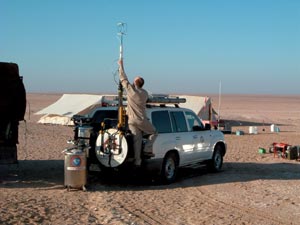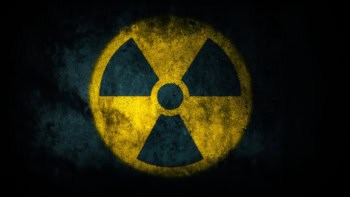A sensor that can detect ethane in trace amounts might also be useful for diagnosing cancer

Dust, sandstorms and extreme variations in temperature make the desert one of the worst places on Earth to perform a delicate optical experiment. However, if that experiment can help to sniff out oil reserves, then it is well worth trying. Physicists from Shell and Glasgow University in the UK have recently returned from Oman, where they have been testing an ultra-sensitive “optical nose” that can detect trace concentrations of ethane. As well as promising a more efficient method of searching for the Earth’s ever-decreasing oil reserves, the new device may also prove effective in diagnosing lung cancer.
Underground oil and gas reserves give rise to microseepage of gases – principally methane and ethane – which escape from cracks in the ground. Unfortunately, due to various organic processes, methane is present throughout the Earth’s atmosphere at a concentration of between 1 and 2 parts per million, and this makes it impossible to distinguish any methane seepage from the background. Ethane, on the other hand, is not produced in organic processes and as long as there are no large cities or petrochemical stocks nearby, the background concentration of ethane is less than one part per billion. An ethane concentration in excess of this may therefore reveal an underground reservoir.
Historically, oil and gas deposits were identified by visible oil seepages at the surface. But as these deposits have became depleted, various techniques have been developed to identify new drill sites. Today most searches for oil rely on explosives or large mechanical “thumpers”, which transmit sound waves into the ground. However, interpreting the reflected sound waves in these seismic surveys takes several months, after which the majority of exploratory drills still turn out to be fruitless. And since it can cost several million pounds to drill an exploratory well, any techniques that can improve the “strike rate” are extremely valuable.
The smell of success
The ethane nose project – which was recently exhibited at the Royal Society’s summer science exhibition in London – began in the late 1990s. Bill Hirst of Shell Global Solutions contacted Graham Gibson and the present author to help develop an ultra-sensitive gas detector that could be used to search for oil in real time (see Physics World August 1998 pp37-40).
At the heart of the sensor is a liquid-nitrogen-cooled laser diode, which generates infrared light at the same wavelength as a molecular transition in ethane. Any molecules of ethane that are present in the sensor will absorb this light, and therefore be detectable. Air is drawn into a 1 m long sample tube, and mirrors at each end of the tube pass the laser light back and forth over 100 times. This creates an absorption length of over 200 m, which means that concentrations of ethane as low as 100 parts per trillion will produce a measurable absorption.
In the laboratory, such an instrument could be regularly tweaked to give optimum operation – an impossible task in the middle of the desert. Instead, sophisticated computer control keeps the mirrors aligned and also monitors the light passing through a reference cell filled with ethane. The complete instrument has a response time of 1 s and is housed within a four-wheel-drive vehicle with a portable generator.
Measuring the gas concentration is one thing; deducing where it has come from is another. To solve this problem we also measure the speed and direction of the wind, from which the ethane concentration at any given downwind position can be predicted. However, “inverting” this problem to find the upwind position – which could be a small source close by or a large source far away – is not possible. Instead, multiple measurements are made at different positions under various wind directions, and this allows an iterative “best guess” solution for the distribution of the gas emissions to be calculated.
The recent trial was our second trip to the Middle East, and the first time that the entire system was tested in the field. By “hiding” an ethane cylinder within the search area we were able to verify that the technique worked.
The desert is an interesting place in which to travel, although driving in the support vehicle feels more like a funfair ride than a scientific experiment. In order to negotiate the sand dunes the tyres have to be deflated to about 15 psi. Working during the summer under such conditions is nearly impossible, but plans are now in place for further surveys in cooler weather, when various oil-prospecting techniques will be compared. The real test of the device, of course, will be when drilling starts.
Spin off
The device could also have applications in a completely different, and slightly more pleasant, environment. While visiting the Glasgow lab, Chris Longbottom of Dundee University surprised us by pointing out that ethane is not just of interest to oil prospectors – it is also a significant bio-marker of oxidative stress. The body’s level of oxidative stress is increased by a variety of diseases, including cancer. In response to the cancer, free radicals in the body increasingly break down cell membranes into hydrocarbons that include ethane, which can be detected in exhaled breath.
Ken Skeldon from Glasgow is now working with Longbottom and his colleagues at Dundee to develop an instrument for breath analysis and the possible detection of lung cancer. The sensor is being used in preliminary trials at Ninewells Hospital, where volunteer patients are providing breath samples for subsequent analysis. In the longer term, breath analysis may also be useful for the detection and monitoring a range of conditions, including cardio-vascular diseases, Alzheimer’s and attention deficit hyperactivity disorder.




